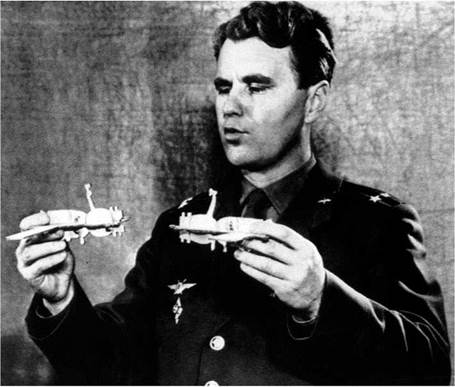1969—SOYUZ 4 AND 5—FIRST DOCKING BETWEEN MANNED SPACECRAFT
Early in 1969, the Soviets laid claim to having formed the first space laboratory with the docking of two manned spacecraft, the first in history. Soyuz 4 with Vladimir Shatalov on board was launched on 14 January. Soyuz 5 was to follow 24 hours later, the delay being to allow time for Shatalov to acclimatize to orbital conditions before attempting the docking. Soyuz 5 had a crew of three, commander Boris Volynov, and flight engineers Aleksei Yeliseyez and Yevgeni Khrunov. The docking was handled manually by both commanders, and was achieved flawlessly; the first docking of two manned spacecraft. However, appearances can be deceptive. Whilst the two spacecraft were physically docked together, it was not possible for the crews to float through the hatches on the nose of the connected orbital modules. Transfer between the two spacecraft was only possible by way of Extravehicular Activity (EVA), or “spacewalking” as it is more popularly known, making use of the side hatches in the orbital modules of both craft. This EVA was a necessary test of the method that
|
Shatalov describes Soyuz 4 and 5 docking |
would be used by a cosmonaut during a Soviet Moon-landing mission. The Soviet lander also had no internal hatch to allow transfer between the vehicles. Yeliseyez and Khrunov carried out the EVA successfully and returned to Earth with Shatalov on board Soyuz 4. Volynov returned with Soyuz 5 alone. Volynov’s re-entry was not without incident, however. He failed to orientate his spacecraft prior to entry, and to add to his problems the propulsion module had not separated completely from his descent module, which caused the spacecraft to tumble and face the wrong way for reentry. Just as Volynov thought that disaster was near, the module separated, and his descent module turned to face the right way. His problems were not over yet; the parachute lines then began to tangle, but fortunately sorted themselves out before the parachutes had fully inflated, and he landed successfully, although much harder than normal, he broke free from his harness, and broke several of his front teeth against the opposite bulkhead. He staggered from his capsule and found a peasant’s hut where the occupants cared for him until help arrived; he was grounded for two years.
It had not been a long duration flight by any means, and the spacecraft remained docked for only four and a half hours, but it had been a successful prelude to manned dockings with orbital space stations, if not perhaps the world’s first space laboratory.











